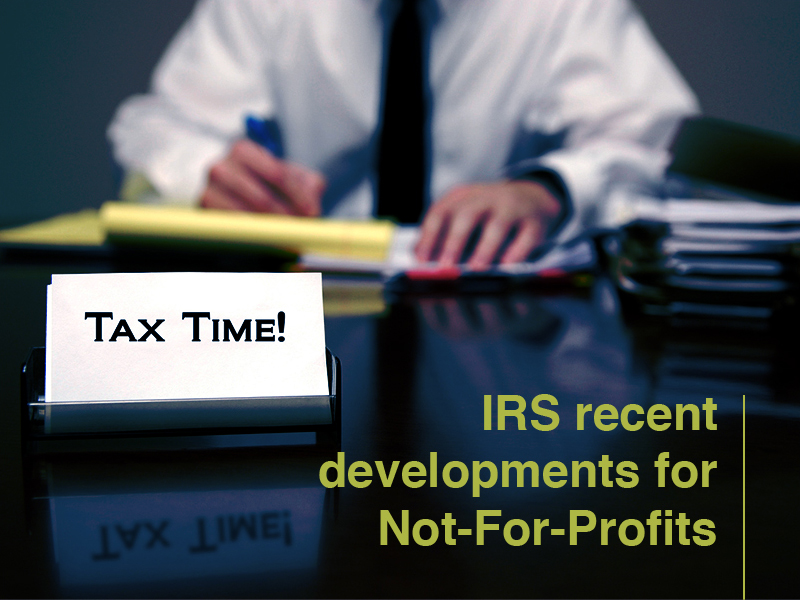The new tax bill has gotten a lot of publicity and generated a lot of buzz over the past few months.
One of the main changes was how it would affect philanthropy – this previous blog post covers it in some detail. But there are other recent IRS developments and ‘hot buttons’ that may also impact your Not-for-Profit.
Though these have attracted less attention, it’s important that you’re across them. We’ve made it easy for you by presenting five of the main areas of change below…
1. Commuter benefits
It is anticipated that many more nonprofits will be filing Form 990-T to report and pay unrelated business income tax (“UBIT”).
As a result of the tax legislation enacted late last year, the IRS recently announced in Publication 15-b that:
“no deduction is allowed for qualified transportation benefits (whether provided directly by you, through a bona fide reimbursement arrangement, or through a compensation reduction agreement) incurred or paid after December 31, 2017.”
Whether your organization is a for-profit or nonprofit, commuter benefits will no longer escape taxation.
Amounts not taxed to the employee will be taxed to the employer, even nonprofit employers.
If you’re tempted to tax your employees on these benefits, check your local ordinances and find out if you’re even allowed to pass the tax on to your employees, in addition to considering the other ramifications.
2. Donor-advised funds (DAFs)
Notice 2017-73 isn’t a new regulation but rather an indication of where the IRS is heading on certain issues.
The IRS has proposed regulations that would prohibit donor advised funds (DAFs) from making a distribution that would subsidize a donor-advisor’s attendance at a special event because it would provide the donor-advisor with a “more than incidental benefit”.
In the same context, the IRS posits that bifurcating the transaction so that the DAF only pays for the charitable donation piece (while the donor pays the charity directly for the portion that represents the fair market value of the meal, entertainment, etc.) still results in a “more than incidental benefit” and suggests that DAFs not be used for event sponsorships.
As discussed in our previous blog post, the IRS is considering a change to the public support test whereby donations received from donor advised funds would be subject to the “2% cap” imposed on donations from private parties.
Also within this notice, the IRS has proposed that, when completing the public support test, all anonymous donations received are treated as being from one donor. This would include distributions from DAFs where the sponsoring organization does not disclose the identity of the donor to the recipient nonprofit.
These changes could potentially threaten the public charity status of some nonprofits by significantly lowering their public support percentage.
On the bright side, the IRS is proposing a regulation that would allow grants from DAFs to be used to satisfy the donor-advisor’s pre-existing pledge obligations (if certain safeguards are met).
3. Payroll/Employment taxes (hot button)
When nonprofit professionals think about compliance with the IRC, they often focus on the plethora of nonprofit-specific nuances: lobbying, the public support test, private inurement, conflicts of interest, proper donor recognition, etc., etc., etc.
However, a significant area of compliance concern for the IRS rests with the somewhat “generic” area of employment tax issues that affect nonprofits and for-profits alike.
It recently announced that compliance checks will be used to look for discrepancies between Form W2 and Form 941 filings, as well as “examination of tax-exempt entities with complex worker classification and/or complex fringe benefit issues.” This includes situations where individuals were paid as independent contractors (1099), who should have been treated as employees (W2).
This IRS webpage is devoted to this very topic. If you pay someone as an independent contractor, make sure you’re not doing so for the “convenience of not putting the person on payroll” but that the situation actually satisfies federal and state requirements. (By the way, proper worker classification at nonprofits is also an issue that the California Employment Development Department is scrutinizing.)
The IRS notes that organizations that are “highest risk of ET noncompliance” are those that paid little or no Social Security and/or Medicare wages compared to independent contractor payments.
4. Private benefit/Private inurement (hot button)
Nonprofits are given tax-exempt status because of their special role in helping society meet unserved needs that further the greater good.
So it should go without saying that the IRS does not want a nonprofit’s charitable resources enriching the pocketbooks of private individuals or non-charitable entities.
The IRS’s Fiscal Year 2018 Compliance Program lists as a strategy: “examine organizations which show indicators of potential private benefit or inurement to individuals or private entities.”
So now would be a good time to review your policies and practices in the areas of conflicts of interest, related party transactions, executive compensation, and expense substantiation and approval.
5. Non-filers and late filers (hot button)
Even being a little late with your 990 can be costly. The late penalties are currently $100 per day for organizations with gross receipts over $1 million and $20 per day for smaller organizations.
Finally, one important provision not to forget is the provision from the Pension Protection Act of 2006, whereby a nonprofit will be subject to automatic revocation of its tax-exempt status if it fails to meet the Form 990 filing requirement for three consecutive years.
Further Reading:
Tax Exempt and Government Entities FY2018 Workplan
https://www.irs.gov/pub/irs-tege/tege_fy2018_work_plan.pdf
Understanding Employee vs. Contractor Designation
https://www.irs.gov/newsroom/understanding-employee-vs-contractor-designation
IRS Notice 2017-73
https://www.irs.gov/pub/irs-drop/n-17-73.pdf


